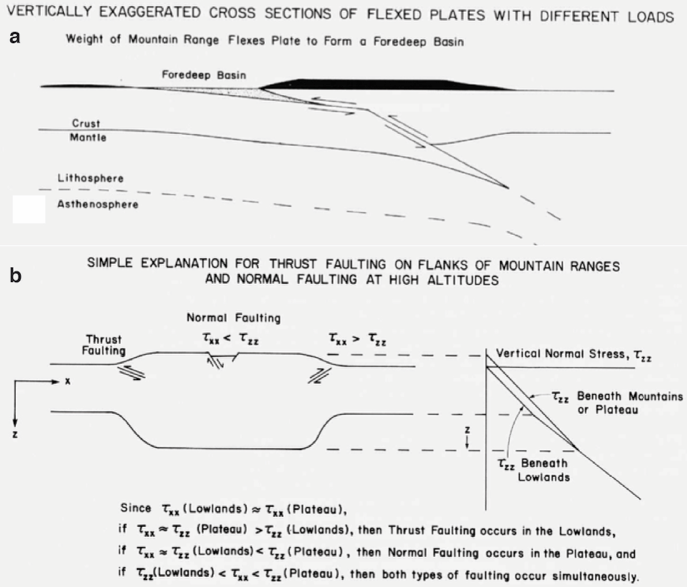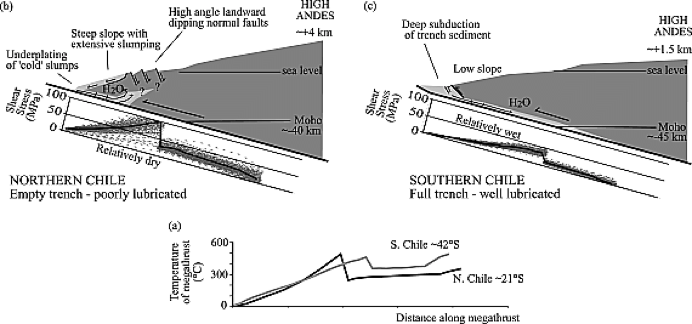
In 1988 Peter Molnar and Hélène Lyon-Caen published their “Must-Read” paper on the support, structure and evolution of mountain belts. It is an article that touches on some core issues of plate tectonics by looking at two types of forces that resist mountain building, using key observations from Asian and American mountain chains. They name the first force “mechanical strength”, and to approximate this force they use the geometry of foredeep basins: topographic depressions filled with sediments that form next to mountain belts as a response to the weight of those mountain belts (Fig. 1a). The second force is gravity, and the authors conclude that an increasing amount of work against gravity is needed to support an increasingly higher range, so mountain ranges will eventually spread laterally instead of upwards. The mean elevations of plateaus can serve as a first order indication for the average compressive stresses pushing on the plateau margins. Key points from the paper are that 1) in terms of physics, the lithosphere can be well approximated as an elastic plate over an inviscid fluid (a fluid for which all surface forces exerted on its boundaries act normal to those boundaries) and 2) that the average strength of the lithosphere at mountain ranges can be derived using the simultaneous occurrence of crustal extension at high altitudes with crustal shortening at the flanks of mountain ranges (Fig. 1b).

Figure 1: Schematic illustrations indicating a) the relation between the weight of a mountain range on a Foredeep Basin and b) an explanation for thrust faulting on flanks of mountain ranges and normal faulting at high altitudes (Molnar and Lyon-Caen, 1988).
The paper is heavily cited and well appreciated by the Earth Science community, and its fundamental principles are still taught in many courses on tectonics and mountain building. Perhaps the most important simplification in Molnar & Lyon-Caen (1988)’s paper is that they did not consider the mechanical implications of having a plate boundary fault. Using a similar approach to Molnar & Lyon-Caen and taking the plate boundary fault into account, Lamb & Davis (2003) conclude that mountain height is related to the force along the megathrust, rather than to the force at which plates are pushed together. Independently though, both papers have the same message: the mean elevations of mountain belts serve as ‘crude pressure gauge’.

Figure 2: The importance of shear stresses at the plate boundary fault for the topographic elevation of mountain chains (Lamb, 2006), largely based on findings in Lamb & Davis (2003).
One of the most significant contributions of this work is the bound on lithospheric strength that they proposed towards the end of the paper. They were probably among the first to provide end-member scenarios in terms of mountain chain height, foreland basin geometries and lithospheric strength, forming a basis for a lot of follow-up work. Schmalholz et al. (2014) is a recent example for a paper building on the basic concepts presented in Molnar & Lyon-Caen, as they consider the gravitational potential energy of the Himalayas and Tibet in order to constrain lithospheric strength. In a more general sense, the mechanical principles presented in the paper are convenient, as they are solid and relatively simple: the limited amount of parameters allows the reader to keep the big picture in mind without getting lost in model complexities. When judging the scientific quality of a model by the number of explained features divided by the number of model parameters (Ben Zion, 2017), this work ranks very high. Both that aspect and the clear writing style make it a perfect introduction for students and other newcomers to the subject. Additionally, this work can be very useful for field geologists as well, as it provides grounded guidelines on where active thrusting and normal faulting can generally be expected within mountain chains.
In the Reddit discussion – feel free to add your thoughts –Utsav Mannu pointed out that the paper is formulated in such a way that it was like reading a scientist’s journal on the way to discovery, and hopes that generations will read this work and come to appreciate the beauty of geodynamics. Gino de Gelder compliments the writing style, and notes that many of the paper’s conclusions now feel very obvious and almost intuitive, but probably it was not so much the case at that time. Armin Dielforder agrees with the points brought forward by the others, and further notes that the absence of a plate boundary fault in the paper may have caused some misconceptions about driving and resistive forces, and perhaps about continental collision.
Written by Gino de Gelder, Armin Dielforder, Utsav Mannu and the TS Must Read team
References:
Ben‐Zion, Y. (2017). On different approaches to modeling. Journal of Geophysical Research, [Solid Earth], 122(1), 558–559. https://doi.org/10.1002/2016JB013922
Lamb, S. (2006). Shear stresses on megathrusts: Implications for mountain building behind subduction zones. Journal of Geophysical Research, 111(B7)./ https://doi.org/10.1029/2005jb003916
Lamb, S., & Davis, P. (2003). Cenozoic climate change as a possible cause for the rise of the Andes. Nature, 425(6960), 792–797. https://doi.org/10.1038/nature02049
Molnar, P., Lyon-Caen, H., & Others. (1988). Some simple physical aspects of the support, structure, and evolution of mountain belts. Processes in Continental Lithospheric Deformation, 218, 179–207. https://doi.org/10.1130/SPE218-p179
Schmalholz, S. M., Medvedev, S., Lechmann, S. M., & Podladchikov, Y. (2014). Relationship between tectonic overpressure, deviatoric stress, driving force, isostasy and gravitational potential energy. Geophysical Journal International, 197(2), 680–696. https://doi.org/10.1093/gji/ggu040

